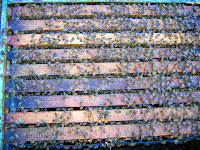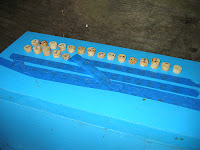I continued feeding the bees for a few days, until last Sunday. On Saturday I placed the queen with 3 frames of bees, brood, and food into a nuc and took her to another apiary. All the uncapped brood went into the neighboring hive along with all but 8 frames I left for this colony. I shook the bees off the frames, of course. I put a super of foundation on top of the single deep box which now contained frames of capped brood, pollen, and uncapped “honey” cells. Because it is a mixture of syrup and real nectar, these “honey” frames will be used for winter food. The super of foundation could get drawn, but the bees seem to prefer the crowded conditions below or hang out on the front porch.*
I use Western frames in my deep hives at a rate of 10-20% because the bees will usually draw drone brood comb in the empty space below the bottom bar of the Western. This allows for more control over the drone population. In this case one of the eight frames was one of those with a very mixed selection of drone larvae ranging from eggs to emerging drones. Beside the queen cells they are the only open brood in the colony and they are there to give the Varroa mites a place to go besides the queen cells. Incidentally, the other two spaces are for the cell frame and the frame feeder.
So the bees, deprived of queen and brood, were well fed, crowded, and ready to draw queen cells. I grafted 30 cells and checked on Monday. Very odd! Only two cells accepted! * Perhaps the Mobile Grafting Lab was too hot (it was above 32 degrees C [90F]). Perhaps they didn’t like the smell of the VSH larvae, who now are fed by their true sisters. They are well fed from the start, too! Lots of royal jelly is given right away.
On Tuesday, I re-grafted. I used one of the cell bars from the previous graft and a new one I had made up on Monday evening. I sacrificed the two accepted cells and smeared their royal jelly in all the cells. The Mobile Grafting Lab was kept between 28 and 30 degrees C (82-86F) and, of course, quite humid.
Wednesday. 29 0f 30 cells accepted! * All looks good, but I think many of the older bees have defected to the neighboring hive…* Which I am slowly moving towards the cell builder colony with a mind to add it’s population to the effort. I’ve got to keep them guessing….










































